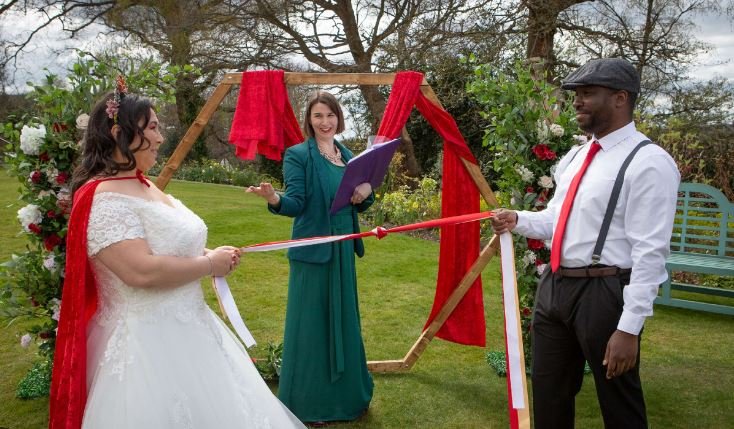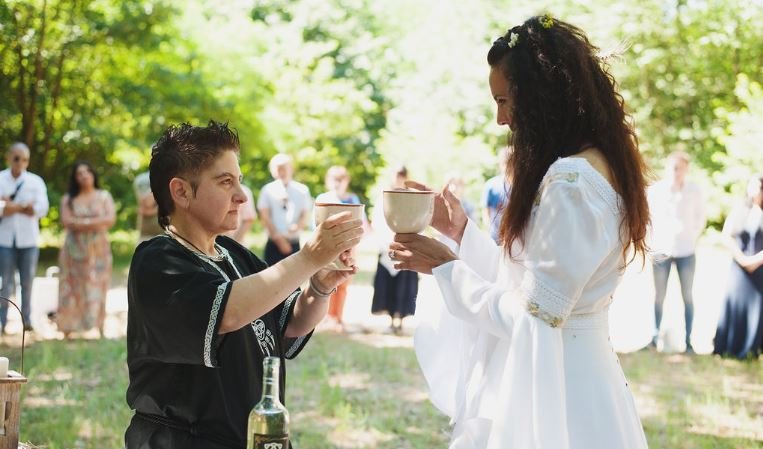The handfasting ceremony is a traditional Irish wedding ritual with deep historical roots. Originating from ancient Celtic customs, this symbolic act represents the binding together of two individuals in marriage. In modern times, handfasting has experienced a resurgence as couples seek to incorporate meaningful traditions into their wedding celebrations. This unique ceremony offers a profound way to symbolize commitment and unity.

Historical Significance
Historically, handfasting was a form of trial marriage in ancient Ireland and Scotland. Couples would commit to each other for a year and a day, after which they could decide whether to continue the union or part ways. The act of tying hands together with a ribbon or cord symbolized their bond and intent. Over time, handfasting evolved into a symbolic ritual performed during wedding ceremonies, signifying the couple’s permanent commitment.
The Ritual Process
During a handfasting ceremony, the couple’s hands are bound together using a ribbon, cord, or rope. This act symbolizes their connection and the strength of their union. The binding usually takes place while the couple stands facing each other, and the officiant or a loved one performs the ritual. The specific colors and patterns of the binding material can hold personal significance, representing various aspects of the couple’s relationship.
Selecting the Binding Material
Choosing the binding material for the handfasting ceremony allows couples to personalize the ritual. Traditionally, the material is a cord or ribbon, often in colors that have symbolic meaning. For example, a red cord might symbolize passion, while a green cord could represent growth and harmony. Couples may also choose to use fabrics that hold personal significance, such as a family heirloom or a cloth from a cherished place.
Incorporating Personal Vows
A handfasting ceremony provides an opportunity for couples to exchange personal vows. These vows are typically spoken during the binding process and can be tailored to reflect the couple’s unique journey and aspirations. The exchange of vows during handfasting adds a deeply personal touch to the ceremony, allowing the couple to articulate their commitment and love for each other in their own words.
Spiritual and Symbolic Meaning
The handfasting ritual carries significant spiritual and symbolic meaning. The act of binding hands together represents the intertwining of lives and destinies. It symbolizes the couple’s intention to support and cherish each other through life’s challenges and joys. The ceremony reflects the couple’s commitment to facing the future together and the strength of their bond.
Modern Adaptations
In contemporary weddings, handfasting has adapted to fit various styles and preferences. Some couples incorporate handfasting into traditional ceremonies, while others choose to make it the focal point of their wedding. Modern adaptations may include personalized vows, the use of non-traditional materials, or incorporating other cultural elements. These adaptations allow couples to make the ritual their own while honoring its historical roots.
Including Family and Friends
Handfasting can also involve family and friends, adding a communal element to the ritual. Loved ones may be invited to place the binding material around the couple’s hands or to offer blessings and well-wishes during the ceremony. Including others in the handfasting ritual fosters a sense of community and support, emphasizing the shared commitment of the couple’s extended circle of friends and family.
Integrating Handfasting into the Wedding Day
Integrating handfasting into the wedding day involves careful planning and coordination. Couples should discuss the ritual with their officiant to ensure it fits seamlessly into the overall ceremony. Considerations include the timing of the ritual, the selection of binding materials, and the incorporation of personal vows. By planning ahead, couples can ensure that handfasting enhances their wedding day experience and reflects their unique story.
Choosing the Right Officiant
Selecting the right officiant is crucial for a successful handfasting ceremony. An officiant with experience in performing traditional rituals can guide the couple through the process and ensure that the ceremony aligns with their vision. Couples may also choose to have a close friend or family member officiate, adding a personal touch to the handfasting ritual.
Capturing the Moment
To preserve the significance of the handfasting ceremony, couples should ensure it is well-documented. Professional photographers or videographers can capture the binding process and the emotional moments shared during the ritual. By capturing these moments, couples can relive the experience and share it with loved ones who may not have been present.
Revisiting the Excitement of Online Casino Games
Online casino games remain a popular choice for those seeking dynamic and engaging digital entertainment. The variety of games and potential for exciting wins make them appealing. To enjoy a wide selection of casino games online, revisit https://www.kingjohnnie.me/en/casino-games. This platform offers a seamless interface and the opportunity to experience the thrill of various casino games whenever you desire.
Post-Ceremony Reflections
After the handfasting ceremony, couples often take time to reflect on the ritual and its meaning. The experience of being bound together in a symbolic way can deepen the couple’s connection and commitment. Reflecting on the ceremony can also help couples appreciate the historical and cultural significance of the handfasting ritual and its place in their wedding celebration.
Planning Your Wedding with Fun and Entertainment
Planning a wedding involves so many exciting details, from choosing the perfect venue to finding the ideal entertainment options. While you focus on making your big day unforgettable, you might also want to explore some fun activities for your guests. For those who enjoy games, gambling360 blackjack is a great way to add excitement to any celebration. Discover ways to bring joy to your guests with thrilling games that can make your wedding day even more memorable.
Conclusion
In conclusion, the handfasting ceremony is a powerful and meaningful Irish wedding ritual that adds depth and tradition to a wedding celebration. By incorporating this ancient practice into their ceremony, couples honor their heritage and symbolize their commitment in a profound way. Whether through traditional or modern adaptations, handfasting offers a unique way to celebrate love and unity on the wedding day.

